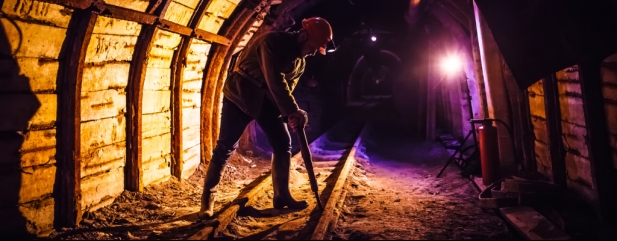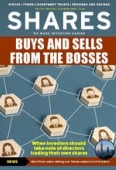Archived article
Please note that tax, investment, pension and ISA rules can change and the information and any views contained in this article may now be inaccurate.
How BlackRock World Mining outperforms by using all the tools at its disposal

The mining sector has had a wild 2022 to date. It started strongly, supported by pent-up demand from the pandemic, with the invasion of Ukraine affecting the supply of key commodities and helping to drive prices even higher.
More recently, concerns about a global downturn, rising interest rates and a stronger dollar have all contributed to a big crash.
With metals prices stabilising and stocks in the sector starting to recover, Shares sat down with the manager of diversified mining investment trust BlackRock World Mining (BRWM), Evy Hambro, to get his perspective on the short and long-term outlook for the miners.
‘I guess the key question shareholders are asking is “where are we in the cycle?”’
Hambro notes ruefully that investors have been asking this question more frequently since what happened in June which, as he observes ‘represented one of the largest one-month falls going back to the Great Financial Crisis’.
SCALE OF SELL-OFF A SHOCK
Hambro adds that the scale of the sell-off came as a bit of a shock given that, unlike in 2007/8, mining firms are not sitting on significant amounts of debt. He observes that with the trust’s gearing at 12% as of the end of June ‘we’re higher than we’ve been in the past and the strategy is absolutely to take advantage of opportunities’.
It says something if Hambro is shocked given the length of his experience. The trust itself was launched in December 1993, and Hambro has been at the helm for more than 20 years. Since 2015 he has been supported by co-manager Olivia Markham.
He is the eldest son of Peter Hambro, who was the founder and one-time chairman of Petropavlovsk (formerly Peter Hambro Mining), the Russian gold miner which filed for administration in the fall-out from the Ukrainian conflict and Russian sanctions.
The trust is one of the most popular in the resources space with more than £1.13 billion in assets. It is also one of the best performers over 10 years in the AIC’s (Association of Investment Companies) Commodities & Natural Resources sector.
BEATING THE TRACKERS
Given many mining companies share prices are heavily tied to commodity prices, it raises the obvious question of why you would invest in an actively-managed fund when you could buy a tracker fund more cheaply. How does Hambro meet this challenge?
‘We’ve done pretty well,’ he responds. ‘I think if you look at the shareholder base it’s pretty much retail and from this perspective the board’s view is very focused on: “what is the value we’re adding?”’
Hambro observes that while they may be more expensive than a tracker there is an emphasis on keeping costs low, ‘much to my irritation,’ he jokes.
The ongoing charge is 0.95% which compares favourably with other resources-focused trusts. As a point of comparison the VanEck Global Mining ETF (GIGB) has an ongoing charge of 0.5%.
In the short-term its performance has been patchy, reflecting the volatility of the underlying market.
However, on a longer-term view it has arguably justified its extra fees. A three-year return of 92.3%, compares with 53.9% for its benchmark and 40.9% for the aforementioned Van Eck ETF. This long-term performance is being rewarded with a 2% premium to net asset value at the current price of 590p.
The trust is backed by the BlackRock natural resources team, the largest in the world by assets, with real depth of expertise.
TOOLS AT ITS DISPOSAL
It also has tools at its disposal like trading in private companies, employing gearing, buying mining royalties and using derivatives.
‘Back in 2010 – the board took the view that in order to maximise the total return available for shareholders we need to ensure we sweated the portfolio as hard as possible,’ Hambro says.
The benefits of the investment in private firms was reflected in two recent IPOs. The larger of which, US battery metals firm Ivanhoe Electric (IE:NYSE), rewarded the trust with, in the words of broker Numis, ‘a near doubling of money (in dollar terms) on the investment’.
The company also has two royalties in its portfolio, including one over a copper and gold mine in Brazil. These are transactions which see mining firms sell future production or revenue in return for an upfront cash payment.
‘These have been successful and we’d love to do more of them but they’re hard to buy as they are an expensive form of financing for resource companies.’
On the unquoted part of the portfolio in general Hambro says: ‘Return expectations have to reflect the fact we don’t have liquidity so we have a higher return expectation.
‘We also put in place safeguards focused on giving us liquidity in a reasonable time frame and we’re trying to be as conservative as possible.
‘We try to buy things into the portfolio as a private investment and will continue to be invested in when they turn public.’
DIVIDENDS DRYING UP
For years miners have focused on paying out generous dividends to shareholders, in part to compensate them for their patience during a difficult period for commodity prices. However, Rio Tinto (RIO) recently signalled a shift, cutting its first-half dividend by more than 50% recently. Does Hambro think we’ve reached the high watermark in terms of dividends from the mining sector?
‘I think mining companies will continue with the same capital allocation policy and look to reinvest back into their business where it makes sense rather than paying special dividends. Given shares are extraordinarily cheap I would expect to see more buybacks announced,’ he says.
INVESTMENT CRITERIA
In terms of the broad investment criteria applied by Hambro and Markham when making decisions, the former says they are looking for ‘quality businesses, well run with strong ESG (environmental, social and governance) credentials’.
‘We try not to invest in countries where there is uncertainty over the mining code and high political risk. However, our view is that Mother Nature put commodities in the ground where she did and you have to back the geology.
‘That geology compensates us for the risks above ground which we can mitigate through diversification.’
When it comes to ESG, Hambro is willing to go on a journey with a company but in order to do so there needs to be a high degree of confidence in the governance. This is the most important of the factors according to Hambro as without the company being run properly you are unlikely to make any progress on the ‘E’ and the ‘S’.
For long-term investors who believe the transition to renewables and electric vehicles, and the associated infrastructure this will require, can underpin metals demand we think BlackRock World Mining looks a logical place to invest.
Its track record is decent, it has solid backing from asset manager BlackRock and a diversified approach which should help mitigate some of the risks associated with investing in this sector.
Important information:
These articles are provided by Shares magazine which is published by AJ Bell Media, a part of AJ Bell. Shares is not written by AJ Bell.
Shares is provided for your general information and use and is not a personal recommendation to invest. It is not intended to be relied upon by you in making or not making any investment decisions. The investments referred to in these articles will not be suitable for all investors. If in doubt please seek appropriate independent financial advice.
Investors acting on the information in these articles do so at their own risk and AJ Bell Media and its staff do not accept liability for losses suffered by investors as a result of their investment decisions.
Issue contents
Exchange-Traded Funds
Great Ideas
News
- US investors chase former ‘meme’ stocks and heavily-shorted shares
- Tesla to do the splits for second time in two years as stock price soars
- Why China’s sabre-rattling over Taiwan matters to UK investors
- Why Next wants to own part of struggling retailer Joules
- Fundsmith among the funds hit by £4.5 billion outflows in June

 magazine
magazine








